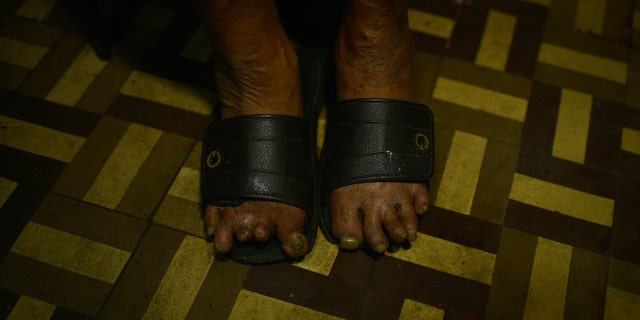Health
As leprosy cases rise in Florida, what you must know about the infectious disease

Experts warn that one of the oldest infectious diseases in history — leprosy, also known as Hansen’s disease — now may be endemic in Florida, according to a recent report.
From 2015 to 2020, 34% of new cases in the U.S. seem to be acquired locally without the traditional risk factor of international travel, where there is widespread disease, the report added.
The report was published in the journal Emerging Infectious Diseases by the Centers for Disease Control and Prevention (CDC).
CASES OF LEPROSY, HISTORICALLY UNCOMMON IN US, SURGE IN CENTRAL FLORIDA, CDC SAYS
New cases have been slowly rising for the last 20 years in the U.S., particularly in the southeastern states in the past decade.
In 2020, 159 cases were reported in the U.S., with 81% of the new cases reported in central Florida, according to the National Hansen’s Disease Program.
Lepromatous leprosy is shown in a 54-year-old man in central Florida in 2022. Leprosy is a chronic disease primarily of the skin and the nerves. (Centers for Disease Control and Prevention)
“Leprosy is a very misunderstood illness,” Dr. Aaron Glatt, chief of infectious diseases at Mount Sinai South Nassau Hospital in Long Island, New York, told Fox News Digital.
“It is nowhere near as contagious as many people think.”
The CDC has not issued any travel advisory due to Hansen’s disease in the U.S.
COVID HOSPITALIZATIONS ARE ON THE RISE, COULD SIGNAL ‘LATE SUMMER WAVE,’ SAYS CDC
“Even with the recent increase in cases in the United States, especially in Florida, leprosy remains very rare in the United States,” Glatt added.
“Most patients with leprosy are easily treated and complications are rare,” he said.
“Most people are not susceptible to the infection.”
“It is critically important, however, to recognize the illness and treat it as soon as possible.”
In ancient times the disease was stigmatized as a punishment of sin by God.
What is Hansen’s disease?
Leprosy is a chronic disease primarily of the skin and nerves, Dr. Jessica K. Fairley, director of Emory Hansen’s Disease Program in Atlanta, Georgia, told Fox News Digital.
It is caused by the bacteria Mycobacterium leprae, the only known bacterium to infect our nerves.
“Most people are not susceptible to the infection and in general, it is very hard to get even when exposed to individuals with the infection,” Fairley added.

It can take up to 20 years after being infected to develop signs of leprosy, but the average time from infection to developing symptoms is approximately five years. “It is critically important … to recognize the illness and treat it as soon as possible,” said one infectious disease expert. (Martin Barraud via Getty Images)
She also said, “We do not even fully understand how it is transmitted.”
Leprosy was renamed Hansen’s disease after the Norwegian scientist Gerhard Henrik Armauer Hansen, who discovered the bacterium as the cause of the disease in 1873.
ANTIBIOTIC RESISTANCE IS ON THE RISE, DOCTOR WARNS: ‘THIS IS AN ENORMOUS PROBLEM’
It can take up to 20 years after being infected to develop signs of the disease, though the average time from infection to developing symptoms is approximately five years, according to the World Health Organization.
People cannot get leprosy from shaking hands, hugging someone or sitting next to someone for a meal.
Some 150 to 250 people are reported to have the illness every year in the U.S., with the majority of new cases in 2018 reported from Arkansas, California, Florida, Hawaii, Louisiana, New York and Texas, according to the CDC.
The disease is common globally, with 250,000 people diagnosed annually; people are more at risk if they live in a country where the disease is widespread, such as India, Brazil and Indonesia, the CDC added.

On Sept. 13, 2018, in Brazil, Rio de Janeiro, the feet of a leprosy patient are shown in a hospital. The person did not want to disclose his identity. (Fabio Teixeira/picture alliance via Getty Images)
Approximately half of all news cases worldwide are diagnosed in India, which is home to one third of the world’s poor — a demographic most affected by the infection.
Leprosy not spread by casual contact
People cannot get leprosy from shaking hands, hugging someone or sitting next to someone for a meal, per the CDC.
DENGUE FEVER CASES COULD REACH NEAR-RECORD HIGHS THIS YEAR: WHAT TO KNOW ABOUT THE TROPICAL INFECTIOUS DISEASE
“Prolonged close contact with someone with leprosy over many months is usually needed before one becomes infected,” Glatt told Fox News Digital.
The disease is transmitted through droplets from the nose and mouth, experts suggest.
But most people — 95% — are naturally immune to the disease.

“The hallmark of Hansen’s disease, which isn’t always present, is a patch of skin that is numb,” said one physician. “Hansen’s disease is fully curable [and] treatable with antibiotics,” she also said. (iStock)
In some parts of the South, experts believe armadillos may spread the disease to people who handle these animals because armadillos are naturally infected with the bacterium that causes the leprosy.
People with leprosy do not need to be isolated from healthy people or live in special places.
NOSE-PICKING FOUND TO SPREAD COVID AMONG HEALTH CARE WORKERS: NEW STUDY
They can live a normal life and go to work and school as long as they are getting appropriate treatment.
Signs and symptoms of leprosy
“Common symptoms are a rash or skin lesions that develop over time and can vary in how they appear,” Fairley told Fox News Digital.
The skin lesions can appear flat or raised and lighter or darker than normal color.
“People can develop numbness of their extremities later on.”
“The hallmark of Hansen’s disease, which isn’t always present, is a patch of skin that is numb,” she added.
CLICK HERE TO SIGN UP FOR OUR HEALTH NEWSLETTER
People can develop numbness of their extremities later on, as the disease progresses.
It is very rare for people to develop deformities of their hands and feet, but timely diagnosis is important to prevent complications.

A leprosy patient holds out his hand at the leprosy hospital in downtown Srinagar on Jan. 30, 2017, in Kashmir, a union territory of India. (TAUSEEF MUSTAFA/AFP via Getty Images)
“Hansen’s disease is fully curable [and] treatable with antibiotics,” Fairley said.
“One piece of advice is to stay away from armadillos, especially their bodily secretions,” she also said.

Health
Your July 2024 Horoscope: Zodiac Sign Monthly Forecast | Woman's World

Sign Up
Create a free account to access exclusive content, play games, solve puzzles, test your pop-culture knowledge and receive special offers.
Already have an account? Login
Forgot your password?
Get back to the Sign In
Use left and right arrow keys to navigate between menu items.
Use escape to exit the menu.
Health
Childhood medical myths debunked as experts weigh in on 5 common warnings

Mothers might know best, but it’s not always easy to separate fact from fiction when it comes to health advice.
A new report from University of California San Francisco (UCSF) Health has broken down several common wellness myths that children often hear while growing up.
Fox News Digital spoke with experts who revealed the truth behind common medical misconceptions.
PSYCHOLOGISTS REVEAL 7 WAYS PARENTS CAN DRIVE HAPPINESS BY HELPING KIDS FIND THEIR PURPOSE
Here are five.
Myth 1. Ginger ale relieves stomach aches
While actual ginger can help ease a stomach ache, most commercial ginger ales don’t actually contain the real thing, Michelle Jaelin, a registered dietitian practicing in Ontario, Canada, told Fox News Digital.
A new report from University of California San Francisco (UCSF) Health reveals the truth about several common wellness myths that children often hear while growing up. (iStock)
This childhood myth persists as parents give ginger ale to children because it’s sweet and bubbly, she said.
“It makes parents feel better that they are doing something for their child when they aren’t feeling well, and the myth persisted as a drink that helps a stomach ache,” Jaelin said.
The carbonated beverages could actually make the stomach pain even worse by increasing gas in the digestive tract, according to Healthline’s website.

Chicken soup has been viewed as a popular cold remedy since at least the 12th century, according to the National Institutes of Health (NIH). (iStock)
Drinks with real ginger also tend to contain excess added sugar, experts said – essentially the equivalent of soda that may worsen stomach pain.
Myth 2. Gum stays in your stomach for seven years
“Swallowed gum does not stay in your stomach for [seven] years, as the myths suggest,” Su-Nui Escobar, a registered dietitian based in Miami, Florida, told Fox News Digital.
“While swallowing gum is not recommended, if you do so accidentally, you will likely pass it like any other indigestible food.”
ASK A DOCTOR: ‘IS IT DANGEROUS TO SWALLOW GUM?’
The gum will pass through the stomach within two hours and be excreted in the stool after approximately two to five days, just like other foods, according to the recent UCSF report.
Although chewing gum can stick to many surfaces — including walls or desks — it travels mostly intact through the gastrointestinal tract without sticking to the intestinal walls, the report notes.

“Swallowed gum does not stay in your stomach for [seven] years, as the myths suggest,” an expert told Fox News Digital. (iStock)
But experts still caution against children swallowing gum, because substantial amounts might cause an intestinal blockage, Escobar warned.
This is a particular concern among children who have underlying constipation, according to Mayo Clinic’s website.
“If you suspect a blockage, seek immediate medical attention,” Escobar advised.
Myth 3. You shouldn’t swim for 30 minutes after eating
As summer kicks into high gear, there is good news for any swimmer itching to get in the water after lunch. Yes, it is usually OK to swim right after you eat.
The myth that you shouldn’t swim immediately after eating stems from a theoretical concern that blood flow will be diverted away from the arms and legs to help digest food, potentially leading to an increased risk of drowning.
“Based on current research, eating before swimming is not affiliated with a risk of drowning, and can be dismissed as a myth.”
But a comprehensive American Red Cross scientific review on the effects of eating before swimming showed no effect on performance in the water after a meal.
“A recent literature review did not provide any information related to an increased risk of drowning due to consuming food before swimming,” Jodi Jensen, PhD, member of the American Red Cross Scientific Advisory Council in Virginia, told Fox News Digital.
AS DROWNING DEATHS INCREASE, EXPERTS OFFER WATER SAFETY TIPS
“There is no supporting evidence from a major medical or safety organization that recommends refraining from eating before engaging in aquatic activities such as swimming,” added Jensen, who is also an assistant professor and aquatics director at Hampton University in Hampton, Virginia.

“There is no supporting evidence from a major medical or safety organization that recommends refraining from eating before engaging in aquatic activities such as swimming,” an expert told Fox News Digital. (iStock)
“Based on current research, eating before swimming is not affiliated with a risk of drowning, and can be dismissed as a myth.”
Although study participants experienced “minimal” side effects at different time intervals after eating, some outside experts do recommend waiting a bit after a meal if you plan to swim laps or compete to avoid any stomach cramping or digestive issues.
Myth 4. Chicken soup cures a cold
Chicken soup has been viewed as a popular cold remedy since at least the 12th century, according to the National Institutes of Health (NIH).
ASK A DOCTOR: ‘DOES CHICKEN SOUP REALLY HELP CURE A COLD?’
“Chicken soup is warm and comforting when you’re sick, but it’s not a cure,” Jaelin told Fox News Digital.
“Chicken soup is warm and comforting when you’re sick, but it’s not a cure.”
“Drinking any hot broth when your sinuses are stuffed can help to clear them out.”
The steam from the chicken broth may relieve a sore throat and congested sinuses, the NIH noted.
For more Health articles, visit www.foxnews/health.
When battling a cold, get plenty of clear fluids to help regulate body temperature and promote improved immune system function, said Jaelin.
“Chicken soup counts toward overall fluid intake,” she added.
It also helps prevent dehydration and clear out mucus, the NIH noted.
Myth 5. You will ruin your eyes if you sit too close to the TV
Sitting too close to the TV will not damage your eyes, though it may cause eye strain, according to the American Academy of Ophthalmology.
NEBRASKA BABY BORN WITH CATARACTS HAS 3 EYE SURGERIES TO SAVE HER SIGHT: ‘I JUST KEPT PRAYING’
To prevent eye strain while watching television, experts recommend keeping the room well-lit and taking occasional breaks from the screen.

Sitting too close to the television will not damage your eyes, but may cause eye strain, according to the American Academy of Ophthalmology. (iStock)
“Children can focus at very close distances better than adults, and may not develop the same eye strain symptoms,” Nishika Reddy, M.D., assistant professor of ophthalmology at Moran Eye Center’s Midvalley Health Center at University of Utah in Murray, Utah, told Fox News Digital.
CLICK HERE TO SIGN UP FOR OUR HEALTH NEWSLETTER
It may be a red flag, though, if children are watching television too closely, experts warned.
The behavior may indicate an underlying vision issue that should be addressed, the UCSF report noted.

The American Academy of Pediatrics says high-quality digital media can be introduced to children between 18 and 24 months of age (only when supervised by parents or caregivers). The academy also recommends limiting screen time to one hour a day for children ages 2 to 5. (iStock)
“See an eye care provider to perform an eye exam for your child,” Reddy recommended.
A more concerning issue is the indirect effect of too much screen time, according to the report.
Although experts say there is no one-size-fits-all guideline when it comes to children and screen time, the American Academy of Pediatrics says high-quality digital media can be introduced to children between 18 and 24 months of age (only when supervised by parents or caregivers).
The academy also recommends limiting screen time to one hour a day for children ages 2 to 5.
Fox News Digital reached out to UCSF for additional comment about its new study.
Health
The Anti-Inflammatory and Mediterranean Diets: Two Immune System-Boosting Diets That Don't Skimp on Flavor | Woman's World

Sign Up
Create a free account to access exclusive content, play games, solve puzzles, test your pop-culture knowledge and receive special offers.
Already have an account? Login
Forgot your password?
Get back to the Sign In
Use left and right arrow keys to navigate between menu items.
Use escape to exit the menu.
-

 News1 week ago
News1 week agoNYC pastor is sentenced to 9 years for fraud, including taking a single mom's $90,000
-

 News1 week ago
News1 week agoRead the Ruling by the Virginia Court of Appeals
-

 News7 days ago
News7 days agoTracking a Single Day at the National Domestic Violence Hotline
-

 Politics1 week ago
Politics1 week agoTrump classified docs judge to weigh alleged 'unlawful' appointment of Special Counsel Jack Smith
-

 News1 week ago
News1 week agoSupreme Court upholds law barring domestic abusers from owning guns in major Second Amendment ruling | CNN Politics
-

 Crypto1 week ago
Crypto1 week agoFactors Driving the Evolution of Cryptocurrency Markets
-

 Politics7 days ago
Politics7 days agoSupreme Court upholds federal gun ban for those under domestic violence restraining orders
-

 News1 week ago
News1 week agoOpinion: Extreme heat kills. What the US can do to protect the most vulnerable | CNN















